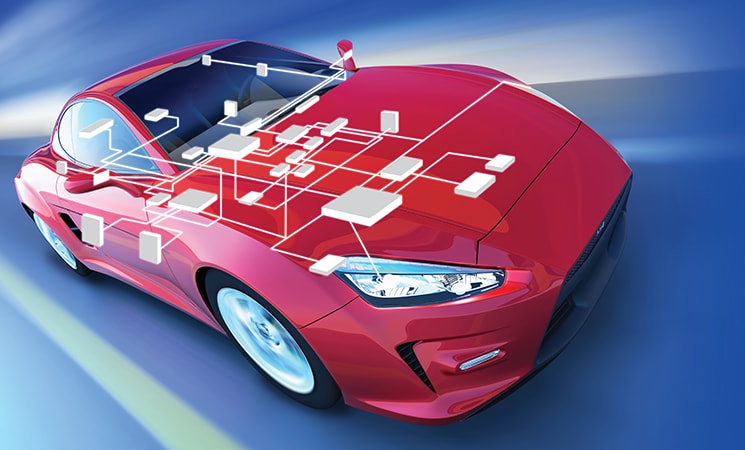What Can’t the CAN Bus Do Today?
From its not-so-humble beginnings in the early 1990s, the Controller Area Network (CAN) bus has expanded from its automotive and industrial roots to connect and interconnect control systems in some of the most dynamic industries on earth (and beyond).

In 1991, I bought a 1979 Fiat Spyder 124 convertible for about $2500. It had 60,000 miles on it and the previous owner had kept it garaged and well-serviced. I was living in Silver Spring, MD at the time so I could look forward to reasonable driving weather on most days. I also had the option to take the Metro (subway) to work when rain or snow made the roads less attractive to drive.
Looking back, the car was probably too small for me, but I didn’t mind. That just made it easier to reach my right arm all the way back to the convertible roof’s handle in case I needed to pull the top up quickly when it rained. You could just slow down to complete that maneuver. No need to pull over or come to a complete stop. The car wasn’t particularly fast, but it was light and could take corners at nearly full speed on its 14-inch wheels, especially the on-ramps to The Capital Beltway (Interstate 495) which rings Washington, DC and its suburban Virginia and Maryland neighbors. The car had a fully-chromed rear luggage rack and the distinctive curves of the legendary Italian design firm Pininfarina.
And that’s about where the nostalgia ends. I had thoughts of teaching myself enough about its uniquely underpowered 4-cylinder engine to make minor repairs and upgrades myself. Armed with a new copy of Chilton’s repair and tune-up guide, my enthusiasm went from 60 to zero as soon as I had a good look at the wiring systems within. Whoever coined the term rat’s nest to describe an intimidating tangle of wires, harnesses and crisscrossing control cables wrapped in electrical tape might have had the Fiat 124 in mind. And this was a car with very few “automatic” features compared to today’s vehicles. It wasn’t long before I found a mechanic who specialized in 1970s Fiats. His shop was always busy.
What I didn’t know was that the first production automobile using a CAN networking approach to in-vehicle connectivity was about to roll off the assembly line and into showrooms that same year. This singular event would both simplify automobile wiring and pave the way for incredibly advanced in-vehicle communications. It would set in motion a wave of networking milestones and quickly reach critical mass among automobile manufacturers. Long before the commercial internet or smartphones or digital media, the introduction of the CAN bus redefined the possibilities for in-vehicle communications and connectivity and triggered a perpetually evolving technology sector that has had far-reaching implications beyond the automobile. The 1991 Mercedes S-class model W140 was the trendsetter, featuring five CAN-connected electronic control units* (ECUs).
Today’s cars include as many as 60 to 100 ECUs and a variety of CAN networks and sub-networks which connect a dizzying number of electronic systems. On-board diagnostics (OBD) systems also leverage CAN-enabled information streams to provide real-time system performance data to drivers, mechanics and the regulatory agencies that monitor vehicle emissions.
Controller Area Network (CAN) Bus Technology
Originally developed for automotive applications by Robert Bosch GmbH in the mid-1980s, the CAN protocol is now a trusted, high-speed standard for applications requiring robust communication and high bandwidth utilization. The classic CAN protocol (ISO 11898) eventually led to the development of a faster standard called CAN FD (ISO 11898-1) to support the growing volumes of data as smart cars get even smarter. Advances in automobile design demand sensor-driven capabilities that enhance driver safety and optimize engine performance with very little human intervention. Engine control units, automatic transmissions, active safety systems, seat control units, door modules, trailer interfaces, parking-assist controls and collision-avoidance systems are continually leveraging CAN bus- and CAN controller- technology during vehicle operation. Data transmission speed and reliability are mission-critical as systems are sharing network capacity while starting, stopping and prioritizing access at the blink of an eye.
A wide spectrum of standards groups has reimagined CAN-based standards over the years for use in non-automotive industries, leveraging its short-messaging capabilities and reasonably fast transmission speeds via market-specific customization of the upper layers of the protocol stack. You will find CAN-based networks in agricultural equipment, aviation electronics, industrial and factory automation systems, smart buildings, medical systems and in many fields that might surprise its original inventors.
In fact, Microchip recently introduced a radiation tolerant microcontroller for space applications that includes a dual CAN controller on top of its Ethernet capability. CAN is being considered as a reliable alternative for control systems in spacecraft too.
Microchip products draw upon our rich heritage in the automotive industry and our commitment to supporting customers throughout their design journeys. Incorporating the CAN protocol into your design is a cost-effective communications option which enables a high degree of real-time capability for simple to complex electrical environments. Microchip offers a complete line of products to meet the needs of high-performance embedded applications using the CAN protocol, including 8-bit, 16-bit and 32-bit microcontrollers, 32-bit microprocessors and digital signal controllers (DSCs) with integrated CAN, external CAN controllers and CAN transceivers. With easy-to-use development systems, code examples, drivers and application notes, Microchip provides a total CAN bus solution that enables low-risk product development, lower total system cost and faster time to market for your high-performance, embedded design.
*Mercedes W140: First Car with CAN, CAN Newsletter Online, March 22, 2016. Visit: https://can-newsletter.org/engineering/applications/160322_25th-anniversary-mercedes-w140-first-car-with-can/